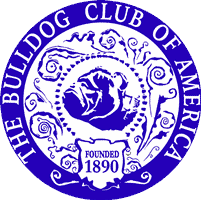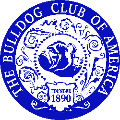At all-breed and Group shows, there is Group judging. The AKC places all breeds within one of seven groups. Bulldogs are in the Non-Sporting Group. The Group judge evaluates each dog against its own breed standard and places them 1 - 4. At all-breed shows, there is further judging of the Group winners for Best in Show. The breeds with similar characteristics are usually assigned to a single group. The dog or bitch awarded Best of Breed in each breed in that group is eligible to compete in the Variety Group competition. There are presently seven groups. The groups are:
Naturally active and alert, Sporting Dogs make like-able, well-rounded companions. Members of the Group include pointers, retrievers, setters and spaniels. Remarkable for their instincts in water and woods, many of these breeds actively continue to participate in hunting and other field activities. Potential owners of Sporting dogs need to realize that most require regular, invigorating exercise.
Most hounds share the common ancestral trait of being used for hunting. Some use acute scenting powers to follow a trail. Others demonstrate a phenomenal gift of stamina as they relentlessly run down quarry. Beyond this, however, generalizations about hounds are hard to come by, since the Group encompasses quite a diverse lot. There are Pharaoh Hounds, Norwegian Elkhounds, Afghans and Beagles, among others. Some hounds share the distinct ability to produce a unique sound known as baying. You'd best sample this sound before you decide to get a hound of your own to be sure it's your cup of tea.
Dogs of the Working Group were bred to perform such jobs as guarding property, pulling sleds and performing water rescues. They have been invaluable assets to man throughout the ages. The Doberman Pinscher, Siberian Husky and Great Dane are included in this Group, to name just a few. Quick to learn, these intelligent, capable animals make solid companions. Their considerable dimensions and strength alone, however, make many working dogs unsuitable as pets for average families. And again, by virtue of their size alone, these dogs must be properly trained.
People familiar with this Group invariably comment on the distinctive terrier personality. These are feisty, energetic dogs whose sizes range from fairly small, as in the Norfolk, Cairn or West Highland White Terrier, to the grand Airedale Terrier. Terriers typically have little tolerance for other animals, including other dogs. Their ancestors were bred to hunt and kill vermin. Many continue to project the attitude that they're always eager for a spirited argument. Most terriers have wiry coats that require special grooming known as stripping in order to maintain a characteristic appearance. In general, they make engaging pets, but require owners with the determination to match their dogs' lively characters.
The diminutive size and winsome expressions of Toy dogs illustrate the main function of this Group: to embody sheer delight. Don't let their tiny stature fool you, though - - many Toys are tough as nails. If you haven't yet experienced the barking of an angry Chihuahua, for example, well, just wait. Toy dogs will always be popular with city dwellers and people without much living space. They make ideal apartment dogs and terrific lap warmers on nippy nights. (Incidentally, small breeds may be found in every Group, not just the Toy Group. We advise everyone to seriously consider getting a small breed, when appropriate, if for no other reason than to minimize some of the problems inherent in canines such as shedding, creating messes and cost of care. And training aside, it's still easier to control a ten-pound dog than it is one ten times that size.)
Non-sporting dogs are a diverse group. Here are sturdy animals with as different personalities and appearances as the Bulldog, Chow Chow, Dalmatian, French Bulldog, and Keeshond. Talk about differences in size, coat, and visage! Some, like the Schipperke and Tibetan Spaniel are uncommon sights in the average neighborhood. Others, however, like the Poodle and Lhasa Apso, have quite a large following. The breeds in the Non-Sporting Group are a varied collection in terms of size, coat, personality and overall appearance.
The Herding Group, created in 1983, is the newest AKC classification; its members were formerly members of the Working Group. All breeds share the fabulous ability to control the movement of other animals. A remarkable example is the low-set Corgi, perhaps one foot tall at the shoulders, that can drive a herd of cows many times its size to pasture by leaping and nipping at their heels. The vast majority of Herding dogs, as household pets, never cross paths with a farm animal. Nevertheless, pure instinct prompts many of these dogs to gently herd their owners, especially the children of the family. In general, these intelligent dogs make excellent companions and respond beautifully to training exercises.


